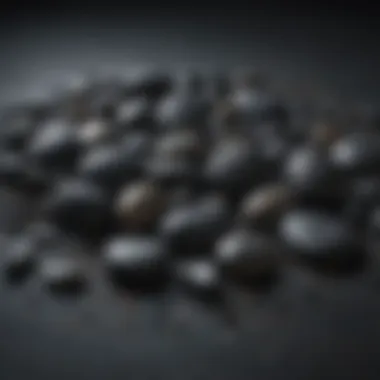Exploring the Beauty of Sparkling Black Stones


Intro
The fascination with black stones that exhibit sparkling properties has captured the attention of many, from casual enthusiasts to seasoned collectors. These natural wonders possess a distinct charm that goes beyond mere aesthetics, delving into the realms of geology, culture, and artistry. With an eye-catching shimmer that glints under light, these stones often provoke questions about their formation, uses, and the stories they carry.
Understanding these geological specimens begins with recognizing their unique traits. The way light interacts with them can reveal insights about their composition and origin. Beyond the sparkle, there's a rich tapestry of history intertwined with their existence. Different cultures have revered these stones, imbuing them with meanings that elevate them from mere minerals to objects of reverence in various traditions.
In this article, we will peel back the layers of these intriguing stones, exploring their natural formation processes, aesthetics, and practical applications, especially in the world of jewelry. Our objective is to weave together a narrative that informs and captivates, appealing to a broad audience hungry for knowledge about the allure of black stones that sparkle.
Featured Collectible of the Month
Overview
This month, we spotlight a stunning example of a black stone with sparkles: Black Tourmaline. Often noted for its deep, rich hue and sparkling qualities, this mineral not only dazzles the eye but also has intriguing properties that collectors and enthusiasts alike find appealing. Found predominantly in Brazil, Africa, and the United States, Black Tourmaline is commonly used in jewelry, adding a touch of glamour while also being thought to have protective qualities.
Historical Significance
Black Tourmaline has long been embraced in various cultures, especially among indigenous peoples of Brazil who utilized it for spiritual protection. Historical records indicate that it was employed in ancient rituals and used as talismans. Today, many still cherish its purported energy-repelling abilities.
"Black Tourmaline is like a guardian, standing watch and warding off negative vibes."
Knowing its background only enhances its appeal, making it an even more captivating collectible. As we delve further, we'll uncover the methods used to identify these gems, the science behind their sparkle, and their broader significance in both modern and historical contexts.
Identification Techniques
Visual Characteristics
When trying to identify black stones with sparkles, look for distinct visual traits:
- Color: Deep black with shiny, often metallic specks of mica or other minerals.
- Luster: A glossy surface that reflects light well.
- Crystalline Structure: Some may exhibit a fibrous or layered structure when observed closely.
It’s important to note that while many black stones may appear similar, the variations in sparkle and texture can often provide the clues needed for accurate identification.
Resources for Identification
For those eager to learn more about identifying these sparkling gems, numerous resources are available:
- Wikipedia: Black Tourmaline
- Britannica: Black stones
- Reddit: Engaging discussions and tips from enthusiasts.
Understanding Black Stones
In the realm of geology, black stones hold a special allure that piques the interests of both enthusiasts and seasoned collectors alike. These stones, often defined by their deep hues and sparkling characteristics, are not just visually captivating; they carry significant geological stories. By understanding what black stones are, their essential features, and how they are formed, one gains a deeper appreciation for their complex nature and intrinsic value. This section serves as the foundation for the exploration of black stones, paving the way for discussions on their formation, identification, and cultural relevance.
Defining Black Stones
Black stones can be broadly classified into various types based on their mineral composition and formation processes. Typically, these stones exhibit a dark color due to the presence of minerals like basalt, obsidian, and certain varieties of granite. Each of these minerals has unique properties that contribute to the overall character of the stone. For instance, basalt is an igneous rock formed from the rapid cooling of lava, while obsidian is formed from rapidly cooled volcanic glass, giving it a distinctive glossy appearance.
The term "black stone" itself encompasses a wide spectrum of geological materials. This diversity means that collectors need to be meticulous with definitions, taking note of factors such as texture, luster, and inclusions. A casual glance might lead one to conflate various types of dark rocks, but understanding the finer characteristics of each can reveal rich insights into their geological heritage.
Importance in Geology
The significance of black stones extends beyond their aesthetic appeal. They serve as vital indicators of geological processes and conditions. For instance, the presence of certain black stones can reveal information about past volcanic activity, tectonic movements, and even climatic shifts. The study of these stones plays a crucial role in understanding the Earth's history.
- Geochemical Markers: The composition of black stones often provides clues about the environment in which they were formed. For example, varying levels of iron and magnesium can shed light on volcanic activity and the temperature of the Earth's crust in certain areas.
- Tectonic Signals: Regions with abundant black stones may indicate tectonic activity. Notably, black basalt formations often arise from areas impacted by tectonic plate movements, revealing profound geological dynamics.
- Cultural and Historical Insights: Furthermore, the historical usage of black stones in tools and jewelry provides insights into human civilization’s connection with geology. It echoes a long-standing relationship that humans have had with materials sourced from the Earth, showcasing how geological elements can shape cultural artifacts.
In summary, understanding black stones involves appreciating their definitions, significance in geological mapping, and cultural connections. They are much more than mere rocks; they are fragments of the Earth’s narrative waiting to be discovered and understood.
Characteristics of Sparkling Black Stones
The allure of sparkling black stones lies not only in their visual appeal but also in their fascinating characteristics that tell stories of geological processes and natural beauty. This section brings into focus the essential elements that define these stones, examining their composition, the source of their sparkle, and the variety that exists within this captivating category.
Mineral Composition


To truly appreciate sparkling black stones, one must first understand their mineral composition, which acts as a fundamental key to their allure. Generally, these stones are comprised mainly of minerals like basalt, obsidian, or even certain types of granite, each contributing unique attributes.
- Basalt: Formed from volcanic activity, basalt is rich in iron and magnesium, which often gives it a dark hue, making it a prime candidate for black stones. When cooled rapidly, it can develop a glassy texture that results in sparkling facets.
- Obsidian: This volcanic glass is famed not just for its jet-black color but also for its potential to display reflective qualities, creating a shimmering effect when polished.
- Granite: In some cases, black stones can include dark granite, which consists of feldspar and quartz, adding sparkly flecks due to the quartz's crystalline structure.
By understanding these minerals, collectors and enthusiasts can gauge not just the aesthetic appeal but also the geological history embedded within each piece.
What Creates Sparkles?
The sparkle seen in black stones often comes from the interplay of light with their mineral composition and surface characteristics. Several factors contribute to this phenomenon:
- Reflective Surface: The degree of polishing significantly impacts how light interacts with the stone. A well-polished surface can reflect light in a way that creates mesmerizing sparkles.
- Inclusions: Some black stones contain natural inclusions, such as tiny metallic minerals, which can catch light and create that sought-after shimmer.
- Crystallization: In stones like granite, the presence of crystals can break light into a spectrum, revealing sparkles that change with the viewing angle.
Understanding these elements offers insight not only into the physical properties of these stones but also into the aesthetic considerations when selecting and displaying them.
Varieties of Sparkling Black Stones
The world of sparkling black stones is diverse, showcasing a variety of forms and types that appeal to different collectors. Here are a few notable varieties:
- Black Tourmaline (Schorl): This gemstone is not only known for its striking black color but also for its unique wards against negative energy, making it popular among spiritual collectors.
- Black Diamond: A true luxury item, black diamonds are highly sought after for their rarity and unique look, featuring a rich complexity in their sparkle due to structural imperfections.
- Labradorite: While often grayish-black, some varieties exhibit a brilliant play of color and sparkle, attributed to the unique refraction of light through its layered structure.
Each of these varieties brings its distinct narrative and aesthetic, enriching the landscape for potenital collectors and gem enthusiasts as they seek to expand their collections or simply enjoy the beauty of nature’s creations.
"The magic of sparkling black stones lies in their duality; their dark exterior conceals a brilliant allure that beckons the observer to delve deeper into their story."
Geological Formation Processes
Understanding the geological formation processes of sparkling black stones is crucial for those who collect, admire, or study these unique mineral formations. It brings to light not just where these stones come from, but how they acquire their distinctive characteristics, especially the sparkling elements. Each of these processes—tectonic activity, volcanic origins, and metamorphic changes—plays a vital role in shaping the stones we find dazzling.
Tectonic Activity and Crystal Formation
Tectonic activity is a driving force in the formation of many geological wonders, including sparkling black stones. As the Earth's tectonic plates shift, they create immense pressure and heat. This environment is ripe for the formation of minerals. When magma moves upward from the mantle, it cools, forming crystals within igneous rocks. For instance, minerals like hornblende and biotite often emerge from such environments, leading to the creation of dark stones that might sparkle when light hits them just right.
Moreover, during an episode of lengthy tectonic upheaval, minerals are also subjected to metamorphic processes. This time of compression can alter existing rocks, creating a highly dense, beautiful structure. Ultimately, the tectonic ballet beneath our feet ensures that there is a continuous supply of new forms for collectors to discover.
Volcanic Origins
Volcanic activity also plays a significant role in the creation of sparkling black stones. When magma erupts, it forms a variety of volcanic rocks, such as basalt and obsidian. These stones, especially basalt, frequently contain tiny crystals that can catch the light, creating an alluring sparkle.
The rapid cooling of lava can trap gas bubbles, which sometimes leads to the formation of air spaces within the rock. In some cases, certain minerals crystallize as the lava cools, leading to that shimmering effect. Picture an explosive eruption in a remote region, followed by a calm aftermath with shimmering stones littering the volcanic landscape, each telling a story of their origin.
Metamorphic Processes
Metamorphic processes are crucial in the transformation of existing rock types into sparkling black stones. When rocks experience extreme temperature and pressure over long periods, their minerals realign and crystallize in new forms. Schist, for example, can form from metamorphosed basalt, resulting in a dark, shiny appearance thanks to its mica content.
This metamorphism creates a stunning interplay of light and shadow, making these stones a prized find for collectors. Not only do they exhibit a stunning aesthetic, but they also showcase the powerful forces of nature at work.
In summary, geological formation processes intertwine beautifully to create the captivating sparkling black stones that many collectors treasure. Understanding these processes enhances one’s appreciation not just for the beauty of these stones, but for the natural artistry behind their creation.
Identification Techniques
The realm of sparkling black stones is as complex as it is beautiful. Understanding how to properly identify these unique specimens is crucial for both collectors and enthusiasts alike. Identification techniques can not only prevent the purchase of imitations but also enhance one's appreciation for the natural artistry these stones possess. By employing a variety of methods, collectors can discern the authentic characteristics of these stones, thus appreciating their geological narrative.
Field Testing Methods
When it comes to identifying sparkling black stones, field testing methods serve as the first line of defense. Collectors often start their journey outdoors where the stones naturally occur. A few practical strategies can aid in proper identification:
- Scratch Test: By trying to scratch the surface with a material of known hardness, one can compare results against Mohs scale of mineral hardness.
- Weight and Density Check: The heft of a stone can provide clues. For example, a heavier stone may indicate a denser mineral composition, which can signal authenticity.
- Cleaning Tests: Rinsing the stone in clear water can reveal its natural luster; if the sparkle remains, it might indicate a genuine sparkling black stone.
These field methods often yield immediate feedback, helping collectors make informed decisions right then and there.
Visual Inspection


Visual inspection is a classic yet underestimated technique that can offer a wealth of information. It involves scrutinizing the stone with the naked eye, focusing on various attributes:
- Color Consistency: Genuine sparkling black stones will often display rich, uniform colors void of abrupt variations.
- Surface Texture: Texture speaks volumes. A smooth yet sparkly surface with small imperfections may indicate natural formation processes, unlike polished imitations that often appear overly smooth.
- Inclusions and Veins: Small natural inclusions or quartz veins can suggest authenticity. If you spot tiny flecks or unusual patterns, they might tell a story of the stone’s formation.
Using Light and Magnification
Finally, one of the most effective identification techniques involves the use of light and magnification. Here are a few effective tips:
- Transmitted Light Testing: Holding the stone against a strong light source can uncover hidden features. Genuine stones might allow a certain degree of light to penetrate, revealing internal structures.
- Gem Loupe: Magnifying the stone with a loupe or jeweler’s microscope can unveil subtle characteristics of the stone's surface, such as striations or internal fractures.
"Using proper identification techniques ensures your collection is not just vast but also genuinely valuable."
- LED Light: A handheld LED flashlight can illuminate the stone in various angles, demonstrating how it reflects light differently than counterfeit materials.
These techniques do not only heighten your ability to identify sparkling black stones but also enrich your overall experience. The more you understand about these geological beauties, the more they draw you into their unique stories.
Applications in Jewelry and Ornamentation
The allure of black stones with sparkles extends well beyond their geological significance; they have carved a niche in the world of jewelry and ornamentation that cannot be overlooked. When one steps into a jewelry store, the shimmer of these intriguing stones often grabs attention instantly. Their use in various adornments—whether it’s a pendant hanging from a necklace or a pair of striking earrings—adds not just beauty but also a unique story to wearers.
Cultural Significance
Cultural perspectives on black stones with sparkles vary widely across different societies. Many cultures ascribe mystical properties or protective qualities to these stones, believing they can bring good fortune or shield against negativity. For example, in several Indigenous cultures, certain black stones such as obsidian are often used in ceremonies and rituals, symbolizing strength and connection to the earth.
Moreover, black stones are sometimes considered a symbol of sophistication and elegance; they appeal to a wide audience from various walks of life. Wearing a piece made from these stones can not only reflect personal style but also signify deeper meanings rooted in cultural heritage.
Design Inspirations
Designers often find themselves captivated by the aesthetics and versatility that black stones with sparkles offer. The contrast of the deep, rich black hues against twinkling flecks creates an engaging visual dynamic. Jewelers can experiment with various cuts and settings, allowing these stones to shine in different lights.
For example, combining sparkling black stones with lighter gemstones can create stunning contrast in piece designs. The art of layering necklaces or stacking rings with these statement pieces can enhance their uniqueness. Additionally, the raw, organic feel of unpolished stones can appeal to those who favor a more natural, earthy style in their jewelry collections.
The world of jewelry design is a canvas, and sparkling black stones provide the perfect paint to create something truly unforgettable.
Durability and Maintenance
When it comes to the usability of sparkling black stones in jewelry, durability is a key consideration. Most of these stones, such as black onyx or hematite, boast a hard surface that can withstand everyday wear—a necessary trait for jewelry designed to be timeless. However, proper maintenance is necessary to keep them looking their best.
For instance, regular cleaning can enhance their shiny appearance and prolong their life. It’s often recommended to gently clean these stones with a soft cloth and mild soapy water, followed by rinsing with plain water. Avoid aggressive chemicals or ultrasonic cleaners as they may dull their shine.
Collecting Sparkling Black Stones
Collecting sparkling black stones is not just a hobby; it's a deep-seated passion for many enthusiasts and collectors. These stones serve as a tangible connection to the Earth’s history, old as time, carrying stories of ancient geological processes. Building a collection of these stones can lead one to not only appreciate their beauty but also understand their ecological and cultural significance. The sparkling facets of these stones capture light in ways that create an enchanting illusion, making them highly sought after in both personal collections and market trades.
Ethics of Collection
When it comes to collecting black stones, ethics play a pivotal role. It isn't just about gathering beautiful stones; it requires a respectful approach towards nature and the environments from which they are sourced. Collectors should understand the environmental impact of their collecting practices. Over-collection in particular areas can lead to ecological imbalance.
One must always seek permission if the stones are located on private property or protected landscapes. Furthermore, sourcing from legitimate and sustainable locations helps in preserving the natural beauty and integrity of these spots. Ethical collecting encourages the practice of seeking out suppliers who embrace environmental responsibility, ensuring that their sourcing does not contribute to habitat destruction.
"Ethical collection nurtures not just our collections but the worlds from which they come."
As fellow collectors share the stories behind their stones, it enhances the value of each piece, reinforcing the importance of responsible stewardship of geological treasures.
Sourcing and Authenticity
The excitement of acquiring sparkling black stones can be somewhat overshadowed if the authenticity of the pieces is not properly established. Counterfeit stones infiltrate the market, and it’s crucial for collectors to be discerning and informed.
Knowing where to source these stones can make all the difference.
- Reputable dealers: Always opt for well-established vendors who provide certificates of authenticity.
- Local stores: Visiting local rock shops can also yield hidden gems and provides the added benefit of speaking directly with the sellers, who can often share valuable information about the stones.
- Mineral shows and fairs: These events not only highlight a diversity of stones but also the stories behind their origins.


Verifying authenticity goes beyond mere paperwork. It’s essential to educate oneself on the characteristics of genuine sparkling black stones, including their mineral compositions and distinguishing features. Engage in communities, such as on Reddit, where experienced collectors share tips and experiences about sourcing and recognizing authentic specimens. With a vigilant eye and ethical compass, collectors can build a captivating collection while ensuring respect for the Earth’s treasures.
Market Trends and Valuation
Understanding the market trends and the valuation of sparkling black stones is crucial for collectors and investors alike. The dynamics of supply and demand, alongside cultural trends, play a significant role in how these stones are perceived and valued. As new discoveries occur, so too does the potential for fluctuations in market value, which can either enhance or diminish the allure of these captivating geological specimens. Engaging with this topic provides a comprehensive view of how sparkling black stones fit into the broader context of mineral collection and investment.
Current Market Trends
The current market for sparkling black stones is evolving, influenced by several factors that shape its trajectory. Here are some notable trends to consider:
- Rising Demand for Unique Pieces: Collectors are increasingly on the lookout for distinctive specimens that stand out. Sparkling black stones, with their rich textures and striking appearance, are often seen as a symbol of individuality.
- Influence of Social Media: Platforms like Instagram and Pinterest have propelled the visibility of these stones, allowing enthusiasts to showcase their collections. This visibility has amplified interest, driving prices up for particularly eye-catching pieces.
- Wellness and Healing Trends: An upsurge in interest surrounding holistic lifestyles has led to a pivot towards mineral collecting for metaphysical purposes. Black stones, often associated with protection and grounding, have gained popularity.
- Sustainable Sourcing: An increasing number of buyers prefer stones that come from ethically sourced environments, reflecting a broader commitment to sustainability. This has encouraged dealers to be transparent about their sourcing practices, which in turn affects market value.
Factors Influencing Value
The valuation of sparkling black stones can be as intricate as the stones themselves. Here are some key factors that often determine their worth:
- Quality of Sparkles: The intensity and distribution of sparkles in a stone can significantly impact its price. The more dazzling and evenly distributed the sparkles, the higher the value.
- Rarity and Source: Stones sourced from unique geological locations often command higher prices. Collectors are willing to pay a premium for pieces that are rare or come with a provenance that highlights their uniqueness.
- Condition and Size: Larger stones with minimal chips or blemishes tend to fetch a higher price. Well-preserved specimens signal to buyers that they are investing in quality.
- Market Sentiment: Unexpected changes in popularity, driven by trends in popular culture or new scientific discoveries, can influence how collectors view certain stones. For instance, a stone featured in a popular film can experience a temporary spike in interest.
In the world of sparkling black stones, the dance between rarity and visibility is a delicate one. Those who grasp it can find themselves either with a trove of treasures or merely collecting dust.
By appreciating these market trends and value determinants, collectors can enhance their acquisition strategies and navigate the complex landscape of sparkling black stones with greater astuteness.
Sparkling Black Stones in Popular Culture
The fascination with sparkling black stones extends far beyond their geological properties. In various cultures and traditions, these stones have found their way into myths, literature, and even modern media, resonating with the human experience in profound ways. Understanding their representation in popular culture not only enriches the appreciation of these geological wonders but also sheds light on their significance across time and space.
Symbolism and Folklore
Throughout history, sparkling black stones have been imbued with symbolic meanings that reflect the values and beliefs of different cultures. For instance, in many traditions, black stones are considered protective talismans. This stems from a belief that their dark hues absorb negative energies, acting as shields against evil spirits. Collectors and enthusiasts might find it intriguing that these stones, often worn as amulets or set into jewelry, were thought to bestow strength and resilience upon their bearers.
In folklore, the shining aspect of these stones often symbolizes mystery and depth. Legends from various cultures depict them as stones of transformation, representing the journey from darkness to light. In some Native American traditions, black stones are associated with the earth's powers and are used in rituals to connect with ancestral spirits. This significance highlights the bond between natural elements and human beliefs, creating a rich tapestry of narratives and meanings.
"In essence, the allure of sparkling black stones lies not just in their beauty, but in the stories they carry, echoing human emotion and history."
These narratives often feed into the fascination of collectors, who seek not only the physical beauty of the stones but also the deeper connections and stories tied to them.
Media and Literature Representations
The intricate connections of sparkling black stones to popular media and literature further amplify their allure. In contemporary films and novels, these stones are frequently depicted as objects of desire, often crossing paths with themes of magic and mystique. In many fantasy genres, such stones often function as powerful artifacts, essential to the plot or character development.
For example, in the fictional universe of The Lord of the Rings, although not explicitly about black stones, the dark reflections and depth in certain gems speak to an inherent nature that connects with the audience’s imagination about hidden powers and histories. This theme resonates with how collectors view their specimens—not merely as geological samples but as narrative devices woven into the fabric of human storytelling.
Furthermore, social media has become a platform where collectors share their finds and narratives associated with specific stones. On sites like Reddit, enthusiasts engage in discussions about mysterious origins, aesthetic qualities, and personal anecdotes linked to their collections. Artwork and photography centered around these stones often showcase their unique features and spark conversations about their cultural backgrounds.
In summary, sparkling black stones have carved a niche for themselves within popular culture. Their symbolism intermingles with folklore narratives, while modern media representations contribute to their ongoing allure. For rock and fossil collectors, these aspects enhance the appreciation of such stones, encouraging them to delve deeper into the history and significance behind each specimen they gather.
Future Trends in Black Stone Crafting
As we navigate this fascinating age of geoscience and craftsmanship, the exploration of black stones with their distinctive sparkles is taking new trajectories. The realm of black stone crafting is undergoing shifts that not only cater to the growing demand for trendy accessories but also align with the rising consciousness about sustainability and functionality. This section will delve into two pivotal areas shaping the future of this craft: technological innovations and sustainability practices.
Technological Innovations
The integration of advanced technology in the crafting of black stones has opened new doors, providing craftsmen and collectors myriad tools to enhance their artistic expressions. For starters, computer-aided design (CAD) software has made designing intricate patterns and settings much more accessible. Artisans can now create virtual models of their pieces, refining them before they even touch the stone. This electronic precision allows for a level of detail and creativity previously constrained by manual methods.
Moreover, we’re noticing the emergence of 3D printing technologies in jewelry design. A designer can quickly prototype creations that incorporate black stones, helping them visualize size, style, and aesthetics without committing to a single source material right away. This means you’re likely to see an increase in custom-designed pieces tailored to individual tastes and preferences.
"Technology doesn't replace the art; it adds another layer—enabling even deeper exploration of creativity and personalization in crafting black stone jewelry."
On another front, laser technology is revolutionizing the way artisans engrave and decorate stones. Lasers create precision cuts that would be near impossible to achieve by hand and allow intricate details that catch the eye, amplifying the sparkle of the stones. Moreover, modern polishing techniques can unleash the full glory of a black stone's lustrous surface, enhancing its sparkle without damaging its integrity.
Sustainability Practices
The growing emphasis on eco-friendly practices is knitting itself into the fabric of the black stone crafting community. Sustainability is not just a trend; it's becoming a necessity. Sourcing materials with a conscience is increasingly influential among collectors and artisans alike. Certified ethical mining practices are gaining ground, ensuring that the stones collected do not come at the cost of environmental degradation or injustice to local communities.
Many artisans are also turning to recycled materials for their designs, crafting stunning pieces that breathe new life into old stones. This trend isn't just about being thrifty; it’s about telling a story. Each recycled piece carries with it a legacy, making jewelry not just an accessory but a conversation starter.
Further accentuating this trend is the popular movement towards local sourcing. By using locally sourced stones, craftsmen reduce transportation emissions and support local economies. Plus, this often leads to more unique pieces, as local stones may have different sparkles or characteristics that aren't found in internationally sourced black stones.



